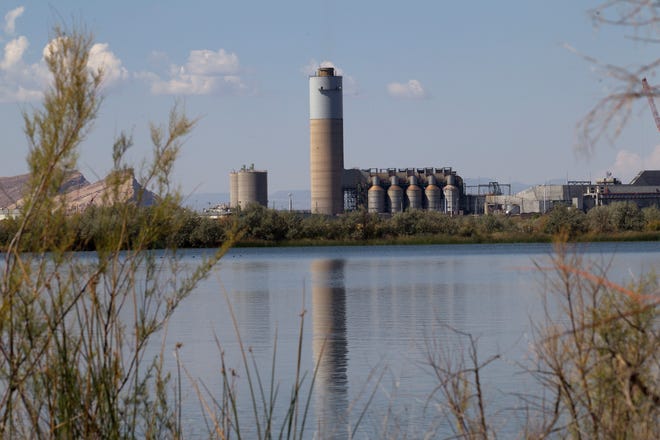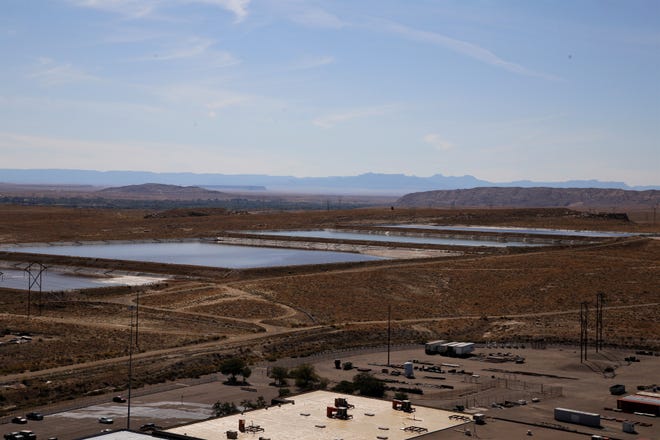Report: As climate change contributes to drought, closure of coal-fired power plants may help
Energy Policy Institute publishes report looking at water requirements of 30 power plants in western United States

- New Mexico coal-fired power plants consumed more than 51 billion gallons of water annually from 2014 through 2018.
- Carbon capture technology increases the water consumption of a power plant.
- Utilities in the Southwest have expressed concern about water shortages in financial filings.
AZTEC — With the Southwest experiencing a drought that is likely only going to worsen with climate change, water becomes an increasingly valuable resource.
For decades, coal-fired power plants in the western United States have used millions of gallons of water each day to produce electricity, according to Joe Smyth, the author of a new report released last week that evaluated water requirements for 30 coal-fired power plants.
The report was published by the Energy Policy Institute, which describes itself as a watchdog entity exposing attacks on renewable energy and holding fossil fuel companies accountable. Smyth is the research and communications manager for the organization.

The report cites data from the Energy Information Agency that shows 30 coal plants in Arizona, New Mexico, Colorado, Utah, Nevada and Wyoming consumed more than 370 billion gallons of water between 2014 and 2018, or about 208 million gallons of water each day.
The three coal-fired power plants in New Mexico consumed more than 51 billion gallons of water annually between 2014 and 2018, the report states, averaging 28 million gallons a day.
As climate change places more and more strain on often overallocated river basins, Smyth said the planned retirements of coal-fired power plants throughout the West opens up a rare opportunity. The pending closure of power plants means less water will have to be used to generate electricity, especially if they are replaced with renewable resources that use little water.

"This sort of circumstance where a very large amount of water that has been used pretty much constantly for decades (is) now becoming available for other uses is basically unheard of or at least very, very rare in the western United States," Smyth said.
The arid conditions and the demand for water are also considerations that Enchant Energy will have to take into account as it works to retrofit the San Juan Generating Station with carbon capture technology.
Smyth said the San Juan Generating Station was unique among the plants he researched because of the effort to keep it open with carbon capture technology. He said the amount of water needed for that to work surprised him. A prefeasibility report estimated it would increase the water usage at the power plant by 50% to 60%, but Smyth said some of the scholarly articles have indicated carbon capture units double the water demand for a power plant.
Utilities concerned with water availability
In the report, Smyth quotes PNM financial reports that have told investors, “If inadequate precipitation occurs in the watershed that supplies that region, PNM may have to decrease generation at these plants. This would require PNM to purchase power to serve customers and/or reduce the ability to sell excess power on the wholesale market and reduce revenues. Drought conditions or actions taken by the court system, regulators, or legislators could limit PNM’s supply of water, which would adversely impact PNM’s business."
PNM is not the only utility that is warning investors about the potential for water shortages. The report highlights 10K filings — financial reports for investors — for the majority owners and operators of the three coal-fired power plants in New Mexico. Last year, all three warned that water availability could impact electricity generation.
Additionally, the report highlights Tucson Electric Power's 2020 integrated resource plan. TEP is a partial owner of the San Juan Generating Station, and the IRP highlighted the water availability as a consideration while planning for future electrical generation. TEP is planning on transitioning to receiving 70% of its energy from renewable sources by 2035, which will decrease water consumption from more than 5 billion gallons annually to about 1 billion gallons each year.
Carbon capture retrofit will increase water consumption at SJGS
The San Juan Generating Station has reduced its water consumption in recent years after shuttering two units, and Enchant Energy does not plan to reopen those units. That means the water consumption at the plant has been reduced. But, as Enchant Energy moves forward with the retrofit, Smyth said the water requirements will need to be one of the considerations.

Enchant Energy COO Peter Mandelstam said it will take more water to capture the carbon dioxide. The two units currently operating require 12,000 acre-feet of water annually, and the carbon capture island will consume 6,000 acre-feet a year, he said. An acre-foot of water is equivalent to 326,000 gallons. That number could increase as Enchant Energy hopes to capture more carbon dioxide. Mandelstam said he challenged the team to look at the project as if there were no water restraints and to determine if they could use more water to capture more carbon dioxide. The answer he received was yes.
Still, water constraints will be something detailed in depth in the upcoming feasibility report that is due to the U.S. Department of Energy next year.
"As a longtime environmentalist, I'm always evaluating all of the trade-offs involved in carbon capture," he said. "When I thought about taking this job, I knew that the area around Farmington was the desert Southwest and so I asked about the water. We're fortunate that there is enough water in this region, and I'm sensitive as a fisherman to maintaining the ecology of rivers and streams. When I think about the benefit of stripping 90% of the CO2 from a power plant that is so vital to the region's economic well-being, and I think about the additional water use that comes from the carbon capture island is 6,000 acre-feet, I think it's a very good trade-off. I have no problem with saying that we're using more water than the coal plant alone because the benefit of using that additional water is stripping all of that carbon and then putting it all in the ground."
All energy technologies have trade-offs, Mandelstam said, adding that there is no perfect technology.
One of the unique things that makes the San Juan site an attractive location for a carbon capture project is that the plant has the water rights to support a four-unit configuration but is currently operating as a two-unit plant, Mandelstam said. Units 2 and 3 were retired in 2017, and Enchant Energy does not plan to bring them back online. In fact, a prefeasibility report conducted by the contractor Sargent & Lundy calls for utilizing the cooling tower from unit 3 to provide cooling for the carbon capture system. The cooling tower for unit 2 has been demolished, and a new cooling tower will need to be built in its place.
Farmington Electric Utility System Director Hank Adair said he is not aware of water shortages impacting electrical generation at any of the city's facilities other than Navajo Dam. The city is a partial owner of the San Juan Generating Station.
Adair said while drought and water shortages are always factors to consider, he does not see them as a hurdle that would stop the carbon capture project from being successful.
He said it is projected to use less water than when the San Juan Generating Station operated on a four-unit configuration.
"(Water) is always something that's focused upon when you're doing an evaluation of a facility and especially with the ... addition of carbon capture, but to date everything we've looked at and vetted and done with our engineering analysis with Sargent & Lundy and the estimated water usage, we believe that it's ... adequate to our needs based on the design today and our current permitting," Adair said.
Hannah Grover covers government for The Daily Times. She can be reached at 505-564-4652 or via email at hgrover@daily-times.com.
Support local journalism with a digital subscription: http://bit.ly/2I6TU0e